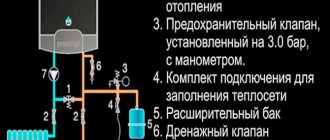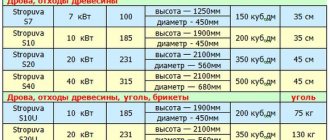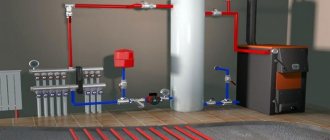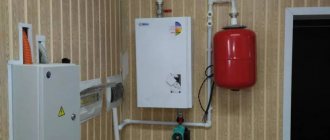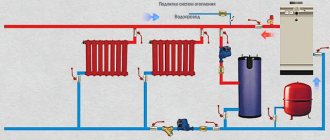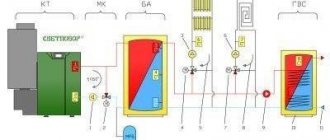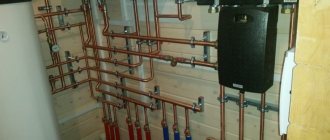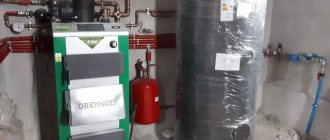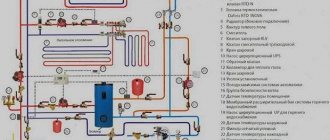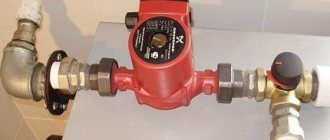Most of the requirements for installing a boiler are described in detail in the passport or recommendations for heating equipment. For a careful and diligent worker, it is almost impossible to make a mistake. Another thing is the installation of the heating circuit.
It is not so easy to piping a boiler with polypropylene. General recommendations, as a rule, are not enough, because you have to take into account the characteristics of the premises. And the boiler piping schemes with polypropylene differ for different types of boilers.
What is boiler piping with polypropylene
In a simplified interpretation, piping a boiler with polypropylene is considered to be a set of control devices with the distribution of heating pipes from the outlet on the boiler heat exchanger, along the circuit, through all the heated rooms of the house or apartment. The quality of the system depends on how correctly the piping scheme is chosen.
What's included in the harness:
- Security group. It includes a pressure gauge, air valve, thermostat. Depending on whether the water will circulate naturally or using a pump, a flow meter and an emergency valve may be included in the group.
- Propylene pipes designed for hot water supply or heating.
- Expansion tank.
- Taps and valves that allow you to regulate the amount of hot water for a specific branch of the piping.
- Dirt filter.
It is generally accepted that the expansion tank is an attribute of all existing boiler piping schemes. But it is not so. Modern gas boilers already have a built-in compensation tank for 1.5-3 liters of water. If the boiler heats a small room, then the built-in tank will suffice.
The use of polypropylene pipes requires the installation of an emergency or steam valve. The essence of the problem is that water heated by the boiler can boil, most often at the entrance to the heating circuit. If this happens, then boiling water and steam will flow further through the pipe, it will reach a section with a tank with an air release valve, and that will be the end of it.
But before the vapor-air plug leaves the system, it will melt the polypropylene. Therefore, when piping a boiler with polypropylene, the valve is installed before water enters the pipes. This is usually a problem with solid fuel boilers, since coal and wood fireboxes have high thermal inertia. If overheating occurs, then it will not be possible to stop the process in seconds.
Simple formulas - for an apartment
Residents of multi-storey buildings can use fairly simple calculation methods that are completely unsuitable for a private home. The simplest calculation of heating radiators is not highly accurate, but it is suitable for apartments with standard ceilings no higher than 2.6 m. Please note that for each room a separate calculation of the number of sections is carried out.
The basis is the statement that heating a square meter of room requires 100 W of radiator thermal power. Accordingly, in order to calculate the amount of heat required for a room, we multiply its area by 100 W. So, for a room with an area of 25 m2, it is necessary to purchase sections with a total power of 2500 W or 2.5 kW. Manufacturers always indicate the heat output of sections on the packaging, for example, 150 W. Surely you already understand what to do next: 2500/150 = 16.6 sections
You should also take into account possible heat loss depending on the location of the room. For example, if this is a room located on the corner of a building, then the thermal power of the batteries can be safely increased by 20% (17 * 1.2 = 20.4 sections); the same number of sections will be needed for a room with a balcony. Please note that if you intend to hide the radiators in a niche or hide them behind a beautiful screen, then you automatically lose up to 20% of the thermal power, which will have to be compensated by the number of sections.
Types and characteristics of pipe products for heating systems
For heating systems, two types of PN25 pipes are used:
- with an internal reinforcing layer of polypropylene and fiberglass;
- with an additional inner shell of aluminum foil.
For piping a boiler with natural circulation, polypropylene reinforced with a mixture of polyethylene and fiberglass is usually used. The pressure is almost equal to atmospheric pressure, the outlet temperature usually does not exceed 80-85 ℃. Therefore, using more expensive pipes with an internal foil lining may be a waste of money.
For gas and electric boilers, the piping can be made from PN25 pipe with any type of reinforcement. Glass-reinforced polyethylene has a lower coefficient of thermal expansion. Polypropylene with aluminum foil is less deformed and sag due to heating.
When soldering with fittings, the foil has to be peeled off, so the labor intensity of assembling the boiler piping is higher.
There is no need to skimp on materials for lining heating boilers with polypropylene in a private home. Firstly, unlike hot water supply, the pipes and fittings of the heating system are constantly under load, which means the risk of leaks in the event of a defect increases sharply.
Secondly, any accident and its elimination with resoldering of polypropylene will cost much more than the benefit from conditional savings on materials. The rupture of polypropylene can cause failure of boiler equipment.
PN25 pipes with aluminum foil can be operated at temperatures up to 95 ℃, the maximum pressure should not exceed 10 atm, operating pressure - 2.5 atm. For the water injection supply line, unreinforced PN10 PPR polyethylene pipe can be used.
Radiator connection of serial type
This option is possible if a condensing gas boiler is used, because The operation of classical equipment is difficult at return temperatures below +55 degrees. The fact is that a cooled heat exchanger collects condensate on its surface. Gas combustion products contain, along with water and carbon dioxide, aggressive acids. In this case, there is a real threat of destruction of steel or copper heat exchangers.
Condensing boilers have a different operating principle. A special stainless steel heat exchanger (economizer) is used to collect combustion products. As a result, additional heat transfer occurs and equipment efficiency increases. Because of this, the return pipe temperature level of +30-40 degrees is optimal. The heating system consists of two series-connected circuits - radiator and in-floor. The return pipe of the first is the supply pipe of the second.
What to choose
It is believed that the choice of PN25 pipes should correspond to the cost of boiler equipment. For cheap wood burning, you can use Chinese pipes. But not the first ones that come to hand, but those that are produced in China under a license from one of the European Union countries, made from imported raw materials using original equipment. For example, the “BLUE OCEAN” brand.
To piping a double-circuit boiler with polypropylene, you can use German products from Banninger or Italian pipes from Valtec. Among the cheaper ones, we can recommend high-quality polypropylene from. They are not capricious during installation and tolerate low temperatures well. Vesbo is the best Turkish pipe for piping.
Did you choose the pipes for piping the boiler yourself?
Options for piping boiler equipment
When choosing a scheme, you will need to pay attention to the design of two separate parts of the heating system:
- boiler equipment safety groups;
- diagram of pipe distribution and heat delivery to the premises.
The safety group configuration depends on the type of boiler. The manufacturer of boiler equipment indicates in the product passport the minimum set of devices that ensure the operation of the unit. He even gives a recommended wiring diagram for the outlet and inlet of the heat exchanger. You just need to install the devices correctly.
You will have to plan the wiring diagram yourself, choose the type of circulation and the method of equalizing pressure throughout the heating system. For low-power boilers, leveling can be done by including bypass valves in the piping. For powerful heating systems, balancing is performed in an intermediate tank - a hydraulic collector or, in other words, a hydraulic arrow.
Forced circulation circuits
The system uses pumping of the coolant, so the heating circuit quickly and evenly warms up to operating temperature. It is best to solder the line from glass-reinforced polypropylene; it gives a relatively small elongation of the pipes, so there will be no problems with deformation of the pipelines.
For apartments and private houses with a small number of rooms, polypropylene piping is often performed using a linear single-pipe scheme. Thanks to the pump supply, hot water moves through the pipe at high speed, so all radiators are heated more or less evenly.
The batteries are connected to the circuit in series one after another. In this case, the supply from the boiler to the radiators and the gaps are made of glass-reinforced polypropylene PN25. The return can be made with a PN20 pipe.
For large rooms and private houses on two floors, piping is often performed by dividing the heating system into several lines. In this case, a distribution manifold is used. The main circulation pump pumps hot water through the boiler heat exchanger and hydrocollector. Due to the high pressure and temperature, both units, supply and return pipes are made of steel.
On the other hand, dedicated hot water supply lines to radiators, heated floors or boilers are connected to the distribution manifold. This part of the harness is made of PN25 polypropylene. Each line is equipped with its own tap and circulation pump.
You can find piping options with a distribution manifold made of polypropylene or metal-plastic. Such schemes are used for heating apartments, for example, in houses for several owners with one boiler and a hot water boiler.
With natural circulation
In private houses and apartments with individual heating, old schemes without forced water circulation can be used. The boiler piping is carried out in the form of a closed loop of two pipes - direct supply and return. Batteries or tubular registers are connected between them.
The direct supply line is often made of steel pipe. The coolant temperature can reach 95-98 ℃. Therefore, polypropylene is not used for piping the boiler outlet. Hot water is directed through the top pipe and returns through a line laid at the level of the boiler heat exchanger inlet fitting. Cooled water is collected in the return, the temperature of which rarely exceeds 60 ℃, so you can install PN20 polypropylene without any problems.
The piping of a heating system with natural circulation must include an expansion tank. According to the diagram, it is installed above the boiler, on a vertical steel pipe with a height of at least 180-200 cm.
A heating system with natural circulation of coolant is also called gravity, but this is not entirely correct. It would be more correct to call it impulse.
The water in the heat exchanger is heated to a high temperature, steam appears under slight excess pressure. The steam flow pushes water up the steel pipe to the level of the expansion tank, lifting it and at the same time saturating it with microbubbles.
In this section of the piping, the microbubbles cool and turn into a liquid state, releasing additional heat and heating the water. The coolant becomes hot and heavy, so due to the difference in levels, the boiling water squeezes out colder water and returns to be heated by the boiler.
An expansion tank must be present in any heating boiler piping scheme, but with a natural circulation scheme, this device additionally ensures the pumping of hot water through the heating circuit.
Common problems and errors
Low efficiency and frequent breakdowns of heating equipment are a clear sign of mistakes made during its installation.
Mistake #1. Most often, problems arise due to insufficient heating of the coolant. As a result, this leads to the appearance of a large amount of tar or soot.
Mistake #2. Incorrect adjustment or lack of protection against boiling water is one of the most common problems. Because of this, the coolant heats up excessively, which negatively affects heating appliances, pipes and other equipment.
Mistake #3
If the heating system is not highly efficient, then you should pay attention to the quality of the sealing. To do this, you need to check whether the boiler and other structural parts of the system are reliably insulated
Criteria for choosing a wiring diagram
The selection of a suitable option begins with determining the type of circulation and the method of replenishing the circuit with water. For a private home, both natural and forced coolant circulation can be used.
If there are no problems with power outages, and the house has a central water supply, then the best option would be a gas boiler with:
- piping made of polypropylene;
- pumping coolant;
- replenishing the system with a drain from the water supply network.
Thanks to the use of a pump and the low temperature of the hot water, there is no need to cut into steel sections. It will be enough to piping polypropylene pipes. The piping of the boiler and radiators is carried out according to a two-pipe scheme.
Strapping for large apartments and houses
For buildings with a heated attic, piping can be done according to a natural circulation scheme. It will be necessary to raise the water tank to the second floor under the attic ceiling. You will need to install washers in the pipework of the upper and lower pipes, preferably taps that regulate the flow of hot water. Otherwise, it will be difficult to balance coolant flows on different floors.
In such schemes, the use of polypropylene in the boiler piping improves the quality of heating, since the internal walls of polypropylene pipes are always smoother than those of steel pipelines.
If in an apartment or house, in addition to heating, the boiler is used as a heat source for a hot water boiler, heating a bathhouse, heating a heated floor, then it is better to choose a piping scheme with a hydraulic arrow.
The same piping scheme can be used for a solid fuel boiler. The security group that controls temperature and pressure will change. It will also be necessary to replace the polypropylene with steel or copper in the area from the boiler outlet to the inlet fitting of the water gun.
Country option
In holiday villages there are always problems with electricity. Either they turn off the lights for several days, or the voltage in the network is clearly not enough for the boiler automation to work, and most importantly, it is possible to start the pump. While it is still possible to install an uninterruptible power supply unit for the combustion front control system, it is difficult to select such a device for the pump, and it is expensive.
In such conditions, wiring is done for a system with natural circulation of water, but with a bypass pump included in the circuit. On smooth propylene pipes, heating with natural circulation will work efficiently, only slightly inferior to schemes with pump supply.
Typically, a pump is needed to quickly warm up a room or remove air from the system. It is turned off at night, since the hum from the running engine can be heard even if the boiler is in the summer kitchen.
Requirements for a room with two boilers
In the case when the same type of heating sources are selected, the requirements for the furnace are applied to the specific type of fuel used: gas, coal, pallets or electric heating.
The boiler room in the house needs to be treated with due attention
If units operating on different types of energy carriers are selected, the premises must comply with both, and the larger indicator is selected.
Requirements for units using solid fuel:
- The floor area of the combustion room is selected according to the total thermal power of the devices: up to 32 kW, 7.50 m2 is required, up to 62 kW - 13.50 m2, up to 200 kW - 15.0 m2.
- A unit of more than 30 kW is installed in the center of the combustion chamber to ensure reliable circulation of air masses.
- The surface elements of the combustion chamber: floor, walls, ceiling and partitions are made of fire-resistant building materials, using waterproofing protection.
- The boiler is installed on a reliable foundation made of fire-resistant building materials.
- For units up to 30 kW, the requirements for fire resistance of the floor are lower; it is enough to cover it with a steel sheet.
- The supply of solid fuel is stored in a separate dry room, and the daily supply can be located in the boiler room at a distance of at least 1 m from the boiler.
- The furnace room must have a door and windows installed that can provide reliable air circulation three times based on the existing volume of the room.
Requirements for furnace units with gas-fired boilers:
- Gas boilers with a total power of up to 30 kW can be installed in non-residential premises of a house where there are windows and doors that can provide 3 times air circulation.
- When the power of the gas source is more than 30 kW, a separate furnace room is required with a ceiling height of at least 2.5 m and a total area of more than 7.5 m2.
- If this equipment will be installed in a kitchen in which a gas stove operates, then the room must be at least 15 m2.
Nuances and piping options for different types of boilers
Most of the problems that arise in the operation of boiler equipment are associated with improper installation of the equipment in the boiler piping. Often, efficient operation is hindered by the wrong type of taps. For example, instead of ball metal ones, installers like to install cheaper models made of polypropylene.
What is the difference? Taps made of polypropylene, especially on the hot water branch, become tightly “welded” after a year, and it is impossible to turn the valve.
Gas equipment
For heating using domestic gas, two types of boilers are used, floor-mounted and wall-mounted. The first type of gas boiler is not much different from classic coal or wood-burning models. Additionally, automatic control of the gas combustion front and a chimney draft presence sensor are installed.
The piping, which should be located on the same level as the heat exchanger, must have an air release valve, a pressure sensor, and a water make-up valve.
Regardless of the model and power of the floor-standing gas boiler, an expansion tank is included in the piping. Especially if the heating circuit is built using a hydraulic arrow. In this case, the expansion tank is placed immediately at the outlet of the boiler heat exchanger.
The relatively low water temperature makes it possible to pipe the premises with polypropylene pipes. Moreover, the distribution manifold is also often assembled by soldering polypropylene tees.
For wall-mounted single- and double-circuit boilers, it is advisable to install expansion tanks, regardless of whether a compensating tank is present in the design. Moreover, a tank is placed in the harness, both on the heating line and on the hot water supply line. Experts advise embedding an air release valve into a polypropylene pipe; this is done at the highest point of the heating circuit.
When assembling the piping, the heating circuit feed line from the water supply is equipped with a dirt filter and a pressure reducer. It is believed that polypropylene, unlike steel, does not produce debris particles, but it is better to include a filter on the piping, since the make-up water may be of poor quality.
Electric heater
Unlike gas boiler equipment, an electric boiler operating in a “heating-pumping” cycle can operate in both cyclic and constant heating modes. The use of polypropylene for piping an electric heater turns out to be even more profitable than steel pipes.
Firstly, polypropylene does not conduct current, so the heating circuit is isolated from the electric heater. We are talking about pipes with fiberglass reinforcement.
Secondly, polypropylene pipelines have a lower thermal conductivity coefficient than steel ones, so less heat is lost. This means that in the bathroom, where there is a heater, a manifold and all the fittings, there will be no “tropics”, while in the rest of the rooms it will be cool.
Only the distribution manifold and the safety group installed in front of it with an air and emergency relief valve are made of metal in the piping. There should not be any other elements except the pressure gauge. If for technological reasons it is necessary to place cranes in front of the group, then after completion of the assembly work the valves are opened and the rotary handles are removed or blocked.
